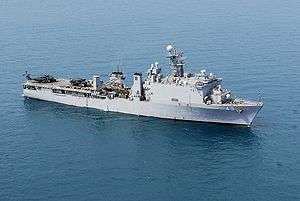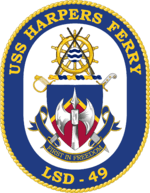USS Harpers Ferry (LSD-49)
 | |
| History | |
|---|---|
| Name: | Harpers Ferry |
| Namesake: | Harpers Ferry, West Virginia |
| Ordered: | 17 June 1988 |
| Builder: | Avondale Shipyards |
| Laid down: | 15 April 1991 |
| Launched: | 16 January 1993 |
| Commissioned: | 7 January 1995 |
| Homeport: | San Diego, California |
| Identification: | LSD-49 |
| Motto: | First in Freedom |
| Status: | in active service |
| Badge: |
 |
| General characteristics | |
| Class and type: | Harpers Ferry-class dock landing ship |
| Displacement: |
|
| Length: | 610 ft (190 m) |
| Beam: | 84 ft (26 m) |
| Draft: | 21 ft (6.4 m) |
| Propulsion: | Four Colt Industries, 16-cylinder diesel engines, with two shafts, 33,000 shp (25,000 kW) |
| Speed: | over 20 knots (37 km/h; 23 mph) |
| Boats & landing craft carried: | 2 × Landing Craft Air Cushion (LCACs) |
| Complement: |
|
| Armament: |
|
USS Harpers Ferry (LSD-49) is the lead ship of her class of landing ship dock of the United States Navy. This warship was named for the town of Harpers Ferry, West Virginia, which, because of the Federal arsenal there, was an important location during the Civil War. USS Harpers Ferry is assigned to the Navy's "Amphibious Group 1". The homeport of Harpers Ferry is at San Diego, California. Harpers Ferry was previously stationed at the American Naval Base in Sasebo, Nagasaki, Japan before she was relieved in 2011 by USS Germantown.
Harpers Ferry's keel was laid down on 15 April 1991, at the Avondale Shipyards in New Orleans. The ship was launched on 16 January 1993. The vessel was commissioned on 7 January 1995.
Operational history
On 1 September 2002, Harpers Ferry relieved Germantown as a forward-deployed warship based in Japan. In 2011, the two ships exchanged places again with Harpers Ferry returning to San Diego, California as its homeport.
Following the Cyclone Nargis disaster in Burma in 2008, and during the following "Operation Caring Response" humanitarian aid mission to Burma, Harpers Ferry steamed in Burmese waters from 13 May to 5 June, waiting for the Burmese junta government to allow American aid to be taken to its citizens. During this operation, she was a part of USS Essex's expeditionary strike group, which also included Juneau and the guided missile destroyer Mustin,[1] However, in early June, with permission to enter Burmese airspace and land areas still not forthcoming from the Burmese government, it was decided to withdraw this aid mission and to return this Naval Task Group back to its previously-scheduled operations.[2]
In October 2009, Harpers Ferry participated in humanitarian rescue operations in the Pangasinan province, of the Philippines, following the impact of a typhoon that caused serious flooding.[3]
In early April 2010, the ship participated in the recovery efforts of the sunken Republic of Korea Navy ship ROKS Cheonan.[4]
This ship was one of several participating in disaster relief after the 2011 Tōhoku earthquake and tsunami.[5]
_prepares_to_moor_pier-side.jpg)
References
- ↑ Martin Fletcher; Joanna Sugden (9 May 2008). "US threatens military aid drops as Burma leaders stall". The Times Online. Retrieved 2010-03-01.
- ↑ "USS Essex Group / 31st MEU Prepare to Resume Previous Operational Schedule" (PDF). Commander, U.S. Pacific Command (USPACOM). 3 June 2008. Retrieved 2010-03-01. Archived 27 March 2009 at the Wayback Machine.
- ↑ TJ Burgonio (9 October 2009). "Defense chief asks US ship to help in Pangasinan rescue". Philippine Daily Inquirer. Retrieved 2010-03-01.
- ↑ Jung Sung-ki, Lee Tae-hoon (2 April 2010). "Torpedo More Probable Cause Than Mine". Korea Times. Retrieved 2010-04-02.
- ↑ Rabiroff, John. "U.S. military delivers 40 tons of supplies to hardest-hit areas," Stars and Stripes (US). 17 March 2011; Seawaves,"Warships Supporting Earthquake in Japan"
- This article includes information collected from the Naval Vessel Register, which, as a U.S. government publication, is in the public domain. The entry can be found here.
External links
| Wikimedia Commons has media related to USS Harpers Ferry (LSD-49). |